19/1
On this part of our journey we are headed once again to Tokyo, this time covering sites along the old Tokaido route. Our first journey is to cross the Wakayama peninsula towards one of Japan's most revered and ancient shrines - Ise Jingu. We arrive at a very grey dark Toba station in the rain after having passed through beautiful mist and clouds. Now too wet and dark to take pictures, and as there is no suitable accommodation we decide to get back on a train and go on to Ukata, which will put us in easier reach of an utamakura at the beach of Kou. In the night we step out of the hotel to find somewhere to eat and settle on a large, but empty Japanese restaurant. Apart from us there is only one other customer; a very drunk man sitting at the counter, grunting. The woman working there is nervous that his inarticulate noises disturb us and sits near him to shush him whenever he starts to moan loudly.
20/1
A bus ride to the beach where the wind whistles through the nets of a golf course that runs the length of the shore.

Maidens on sailing ships pass by
Their red sleeves trail
In the water of Ago bay
And fill with the tide
Anon. Man'yoshu Vol.15 #3610
Going back to Ukata we pick up our luggage and then go on to Toba to catch a ferry to Toushijima, a small island in the bay of Ise, visited by one of the Man'yoshu's most illustrious poets. The concrete tetrapods that surround the small hill that is the utamakura are a very particular shape; Like Escher in three dimensions. Crows and hawks hover over the cape.
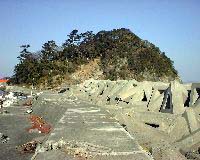
This day too,
At the cape of Tafushi
With their bracelets of shell,
Are the courtiers gathering seaweed?
Kakinomoto no Hitomaro. Man'yoshu Vol.3 #41
On the way back to Toba on the ferry the wind bites very cold, but it looks like a summer sunset. From the port we travel on to the town of Ise. After dinner we walk around and come to the outskirts of the outer shrine which, in the dark, appears as an impenetrable forest.
21/1
The dawn comes up slowly through patchy clouds, at the outer shrine there are many guards dressed in heavy navy blue coats with gold trimming, and an unusual number of surveillance cameras. Scattered through the grounds at the foot of twisted trees are offerings and tiny wooden torii - temple gates. We go on to the inner shrine, the very central part of which we cannot enter, but we see the bright glint of the golden roof work shining through the trees above the wall of the enclosure. At the entrance a pure white cloth flaps in the cold winter wind flashing us glimpses of the shrine within, while nearby a shinto priest is in prayer. On the way back to the gate we come across a solitary white horse, its head hung low, standing quietly in a stable.

It is now late in the morning, and we take a train to Matsuzaka and from there take a bus to Higashi Kurobe which at the time of the Man'yoshu used to be known as Matokata. In the strong wind occasional sun pierces the clouds and although the area is an empty plain it is strangely impressive. The first character of Matokata is also the word for 'target' and the uta for this place revolves around this homonym or 'kakekotoba',
Brave warriors
Shooting arrows straight to their targets
Pure to my view -
Matokata
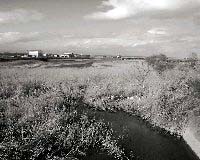
22/1
Leaving for Nagoya, we pass by Akuragawa, which in Man'you times was on the coast. Now the Utamakura of Shide temple is landlocked and a line of factories stands between it and the sea. The temple itself is buried in the shadow of surrounding trees and as it would not make an interesting picture I am about to admit defeat and move on without getting my camera out when we come across a small allotment amongst the houses. Fixed to a barren tree are black strips of vinyl that wave in the breeze and the scene seems to fit the poem,
At Cape Shide
I think of you in Nara -
Tying a thread on these boughs
I pray for our happiness
Anon. Man'yoshu Vol. 6 #1031

At Nagoya, before meeting an old friend we visit Sakurada, a hill that once looked out over the sea.
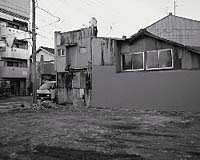
The cry of cranes
As they fly to Sakurada
And the tide has ebbed from Ayuchi bay -
The cry of cranes as they pass by
23/1
A bright hazy day. Before we leave Nagoya we must try to take a picture of Chita bay, but as factories cover the coastline we do not know how we can get to the shore. We take a train to what we think is the nearest station to the bay, thinking we will be able to walk from there, but instead we take a taxi, and ask the driver to take us to the sea. With increasing discomfort we watch the fare on the meter rise into thousands of yen as we wait for him to drop us off somewhere. In the end any worries about his honesty are put aside as we eventually end up at what seems to be the only place with public access to the water side; a long bar of concrete for fishing from presided over by two gigantic smokestacks.

Vanishing tide
At Chita bay, the ships rowed out
In the morning
seem too far from the shore
24/1
Irago. An hour and a half bus ride from the nearest train station, when we get on the bus, one of the other passengers is a young man who cannot sit still, his head darts from side to side as if he cannot bear to miss anything from the window. Then he cannot decide on a seat and keeps moving in the bus. At first, his behaviour is irritating and makes me angry, and then I realise that he is mentally disturbed; his face is blank and his mouth hangs open slackly. I wonder about my own reaction to his behaviour, which now I realise was wholly unnecessary.
At Irago port there is a lively business at the ferry terminal with plenty of people waiting to catch the boat to Toba, but a few yards away rubbish and concrete make for an empty and unappealing shoreline. Heavy fog hangs over us and out to sea, ships and islands drift in and out of view. Here the nobleman Prince Omi contemplated his conviction and exile from court -
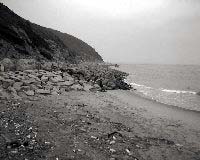
My life
Sorrowful life in this world
Soaked by the waves
On Irago island
I harvest seaweed
Man'yoshu Vol 1 #24
However, we walk a kilometre around the promontory on which the lighthouse stands and find a long empty beach of white sand. Despite the dirty wet weather, the water of the Pacific is a pure aquamarine, and the translucent inner curve of the waves is deeply peaceful.
On the bus back an old man tries to spark up a conversation with us to which in my minimal Japanese I am polite but non-committal. As it turns out he also is mentally disturbed, and I watch while he tries to talk to other people on the bus. When it comes to his stop he engages the bus driver in a long and illogical discussion, the bus driver, however, remains calm and polite throughout.
25/1
Far inland now, at the town of Iwata:
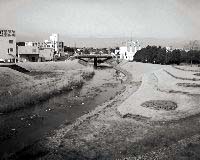
Endlessly the waves
Caress the long beach at Ono bay
As I long for my love
Without end
Emperor Shomu. Man'yoshu Vol.8 #1615
At Yaizu we check into a cheap business hotel and then take a bus to the Oi river. At first bright and sunny, as we stand on a bridge over the river that is trembling from the passage of heavy trucks the sky turns black and for a brief moment we see Mount Fuji before it starts raining.
The boats in the morning
On Shida bay
Are they rowed without purpose?
No, not without reason
Anon. Man'yoshu Vol.14 #3430
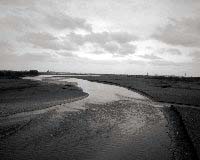
26/1
Mt Fuji flashes in and out of view as the day passes, when appearing it dominates everything in sight. We visit the shrine at Kiyominosaki which is oddly placed, cut in half by a railway line passing through it. Once boasting a fine view of the bay - Tago no Ura - now the shrine looks over a container yard and giant gantry cranes. On the sea journey to assume the governorship of Kamitsuke (in present day Gumma prefecture) Lord Taguchi Masuhito wrote:
Glittering in the sunlight
I can look endlessly
At the bay at Tago -
Bowing to the order of my sovereign
I look now in the darkness of night
Man'yoshu Vol. 3 #297
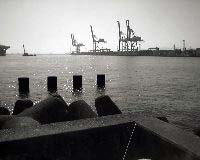
At Shizuoka we stop to drop off our luggage, which these last few days the weight of which has been making me short-tempered and unreasonable, and then go on with just the camera equipment to Fujikawa. We are here to take a picture of the river, but somewhat uncommonly there is no path to the water's edge. Strangely complete items of garbage litter the riverbank - a wetsuit carefully laid flat on the rocks, a nearly new motorbike propped upright on its stand, a car driven into the river, its trunk end stuck up in the air. Mt Fuji in an otherwise empty blue sky creates an ever renewing cloak of white cloud. In our frustrated wait for it to appear we tramp through rotting unattended allotments, mosquitoes and marsh to finally drop down to the river's edge where there is a wide beach of chalk pebbles.

High peak of Mount Fuji
In its honour
Even the sacred clouds
Part and trail behind
Anon. Man'yoshu Vol.3 #320
We spend the night at an old friend's house in Shizuoka. As we have not seen each other for five years I am in that unpleasant predicament of having a lot to tell and little to say.
27/1
My verbal paralysis lasts all day as we poke around in our friend's car looking for a good spot to take a picture of the bay - Tago no Ura, which was originally celebrated for its view of Mt Fuji. The original area of the utamakura is mostly taken up by a busy highway, and the area that is now referred to as Tago no Ura belches smoke and steam from a multitude of large factories. In both cases the shoreline is not generally accessible, however we find a place to follow the river at Yui down to the sea where there is a stony beach and a very friendly dog who keeps us company for an hour or so.
We stay another night at our friend's house and meet her husband who runs a second-hand jazz and soul record shop. After plenty of beer and Chinese brandy we talk late into the night about Japan in the midst of the present depression and what might happen in the future.
28/1
A clear wintry day; we leave for Tokyo and on the way stop at the town of Fuji to take a picture of the landscape of factories with Mt. Fuji in the distance,
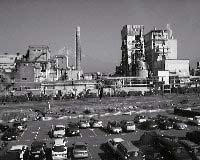
Never again to meet my lover -
As the high peak of Fuji
In the land of Suruga burns within
So shall I
Anon. Man'yoshu #2703
We arrive at Tokyo station at night and stay the night in a cramped business hotel named 'Heimat'.
29/1 - 5/2
Almost as soon as we have found a place to spend the week in Komagome - a residential area of Tokyo - Tamiko goes down with flu. Consequently much of our time is spent in the tiny area of our weekly mansion. With so little room and not much to do the smallest actions of daily life - making tea, having a shower - become strangely distorted into major operations. In between mopping Tamiko's brow and various meetings I only have the opportunity for two excursions - one to the suburb of Ichikawamama and then to Sumida river. At Ichikawamama, known as Katsuhikanomama in the man'you period, the day is heavy and the light is a sickly yellow-grey. Here many uta are sung to the grave of the beautiful maiden Tekona who, courted by innumerable suitors, committed suicide to avoid having to choose among them.
Thoughts of Tekona
Seeing the well at Katsuhikanomama,
Knowing that it was here she stood
To get fresh water.
Takahashi Sakimaro. Man'yoshu Vol.9 #1808
Later in the week I walk along the northern part of Sumida river looking for a suitable place to take a photograph, under every bridge it seems there is a little cardboard and blue vinyl bivouac with a pathetic collection of collected objects.

The most famous uta about the Sumida is by the notorious lover-poet Ariwara no Narihira, who on travelling east reached the river and about to board a ferry became nostalgic for the capital in Nara and the people left behind. At this point he sees a bird which the ferryman identifies as a 'capital bird' or Miyakodori. To this the poet sings:
If you are truly
Of your name
I ask you this, Miyakodori
What news of my love?
Kokinshu #411
Tomorrow we go back to Kansai, and then on to Kyushu to spend a week covering the area of Otomo no Tabito's governorship. We are now more than half way through our journey and as the days get longer and the sky brighter the end of each leg brings our return to England closer. Despite the bitter winter wind I cannot help having a certain deep-down envy of a man who lives under a bridge with no social obligations.
|
|
1999年1月19日
大阪で雑用を済ませ、地下鉄で谷町9丁目まで行き近鉄特急で1時間半の伊勢市へ向かう。つもりだったが、車中予定を変更して鳥羽まで乗り越すことにする。乗り越し清算をして改札を出るが、辺りにホテルの気配は全く無し。水族館とおみやげ屋ばかりが目に付くばかり。雨も降り出し、歩き回って探すことも出来そうにない。電話帳をめくってわかったのは、どうも鳥羽は団体旅行客向きオンリーの超豪華観光ホテルしかないらしい。またもや急遽予定を変更して更に南の鵜方へ行くことにする。再び30分ほど近鉄電車に揺られ、駅前のビジネスホテルにチェックインする頃には既にとっぷり日が暮れていた。
鵜方泊
1999年1月20日
バスで国府まで行く。読み仮名は「こう」と書くが「こお」と読む。バスを降りて海の方向と思われる方へ歩く。この辺りの家々は垣根代わりに槙の木を植えている。その間を通り抜けると海、と思ったらゴルフ場。海岸に沿って幅は狭いが1キロほど砂浜に芝を植えられたゴルフ場が細長く伸びている。「飛んでくるゴルフボールにご注意」の看板を横目に見つつゴルフ場を横切って海岸へ。防波堤の隙間から既に真っ青な海が覗いている。サングラスをかけていても意味が無いほど太陽が照りつけている。遠くでサーフィンをする人二人。手前でも一人。防波堤に腰掛けて海を眺める。
安胡の浦に 舟乗りすらむ 娘子らが 赤裳の裾に 潮満つらむか (万葉集 15-3610)
近鉄電車で鳥羽へ戻る。フェリーが出る時間を睨みながらばたばたお昼を食べ、1時半のフェリーで答志島へ。約30分の船旅。答志港には、数えられないほどの漁船が停泊している。2人の釣り人が堤防に腰掛けてのんびり釣り糸を繰っている。頭上で広がる空と雲を眺めながらゆっくり流れる島の時間を感じる。2時間ほどの撮影後、夕陽に染まる海を眺めながら鳥羽へ戻り、電車で宇治山田駅へ。
くしろつく たふしの崎に 今日もかも 大宮人の 玉藻刈るらむ
(柿本人麻呂 万葉集 1-41)
伊勢泊
1999年1月21日
宇治山田駅からも伊勢市駅からも徒歩数分という泊まっているウィークリーマンションの地の利を生かし、朝まず歩いて伊勢神宮外宮へ。ひととおり見た後タクシーで内宮へ向かう。宮内を流れる川で撮影していると、「魚、いますかあ?」と走り寄りながら聞くおじさんがいるので、いえ、いませんと答えるとがっかりした様子をあからさまに見せ、一応自分でも確かめるように水中を覗き込んでいる。その後次々に団体旅行の人達がガイドさんに連れられてやってきてはしきりに魚を探しているので、いないってばと思いつつもう一度覗くと、びっくりするくらい大きな見事な鯉がふいに石の下からぬうと姿を見せる。これか。確かに立派なやつだ。巨体をあくまでゆったり水に任せて微動だにしない。それからじっと見ているとどこからか真っ白なのも2匹出てくる。伊勢神宮では馬も鯉も白いかと感心。
いったん戻って休憩。その後JRで伊勢市から松阪へ。松阪牛ステーキランチを食す陰謀を企てるものの、バスの時間まで20分しかなくあえなく断念。次のバスは2時間後でそれだと日暮れに間に合わない。泣く泣くマクドナルドで食べて、路線バスのくせに16人乗りマイクロバスの市バスに乗り東黒部へ向かう。松阪から30分ほどの距離だが、マイクロバスがしかも2時間毎にしか来ないだけあって見事な田舎。いやな予感に襲われつつ帰りのバスに時刻を確かめると、やはり15分後の次は3時間後。帰りはタクシーと決め、とりあえず辺りを歩きまわる。この辺りは的形と呼ばれた地。
ますらをの さつ矢たばさみ 立ち向かひ 射る的形は 見るにさやけし
(万葉集 1-61)
的形の 湊の渚鳥 波立てや 妻呼び立てて 辺に近付くも (万葉集 7-1162)
田んぼの畦道をずかずか歩いてすぐ近くに思えた堤防まで行くことにする。その向こうは伊勢湾のはずだ。が、歩いても歩いても堤防は近づいてこない。畦道がゆらゆら曲がりくねっているのも一因かとは思うが、あまりに一面田んぼなので距離を読めなかったというのが主な敗因らしい。これでもか、これでもかと歩き続けてようやく堤防に当たる。高い高い堤防の向こうには、やはり伊勢湾が広がっている。空の色を映して黒みがかった色をしている。
伊勢市泊
1999年1月22日
伊勢市から近鉄で安倉川へ。駅前の自転車屋さんに荷物を預かってもらい徒歩で志太神社へ行き、近辺で撮影。
後れにし 人を偲はく 思泥の崎 木綿取り垂でて 幸くとそ思ふ (万葉集 6-1031)
駅に戻り電車で名古屋へ。ここで松阪牛ステーキを再襲しようとするも、駅前にお店が見つからずまたも断念。代わりにみそおでん定食を食べ、JRに乗り笠寺駅まで行き撮影。駅から北東方向としかわからなかったため、闇雲にその方向へ向かって歩くうち、当たり前だが迷子になる。人に道を尋ねながらようやく辿り着く。迷子の間思ったが、やはり名古屋は喫茶店だらけの町だ。過剰サービス競争になるはずだと深く納得。南区のこの辺りは桜田と呼ばれ、すぐ南はもう海だったらしい。今はすっかり住宅地で、観音様や焼き芋売りが幅を利かせる下町の雰囲気があふれている。
桜田へ 鶴鳴き渡る 年魚市潟 潮干にけらし 鶴鳴き渡る
(高市連黒人 万葉集 3-271)
夕食は名古屋在住の友達と彼の婚約者にシブイ小料理屋に連れて行ってもらい石狩鍋を食べる。松阪牛の怨みを忘れるおいしさ。
名古屋泊
1999年1月23日
名古屋ではJRや近鉄以上に威張っている(ような気がする)「めいてつ」こと名古屋鉄道で太田川駅まで行き、知多湾の写真を撮りたいので海まで、とタクシーの運転手さんに頼むとタクシーはぐんぐんスピードとメーターを上げて私たちをどきどきさせながら、巨大工場群を走り抜け海釣公園までやって来る。えらく高くついたタクシー代を補って余るほど、ここの公園は良い。伊勢湾台風の後、湾を高波から守る目的で作られた数キロに及ぶ防波堤がそのまま釣り公園になっており、土曜日の今日、朝から大勢の人が釣り糸を垂らしている。防波堤と管理塔のある一部を除いてあとはどでかい工場の建物が延々と続き、ぼくぼくとグレイがかった煙を吐き出す煙突が連なっているその前に見渡す限り広がる青い海と空の風景は圧巻。
年魚市潟 潮干にけらし 知多の浦に 朝漕ぐ舟も 沖に寄る見ゆ (万葉集 7-1163)
帰りはタクシーを呼び最寄りの朝倉駅まで行き名鉄で名古屋まで戻りJRに乗り換え豊橋へ。
豊橋泊
1999年1月24日
三重鉄道バスに乗って渥美半島先端の伊良湖岬へ向かう。藤村の詠う、名も知らぬ遠き島より椰子の実が流れてくるところだ。バスには他におばあちゃん1人、20代の男性1人、計4人でバス貸し切り状態。途中、運転手が寝ているとJohnが騒ぐので驚くが、バックミラーの角度で目が閉じたように見えることが判明し安心する。伊良湖岬バス停で降りると能登半島羽咋のなぎさドライブウェイで見たような1階が御土産売り場、2階がレストランという大型ドライブインのようなものがあり、ここにも「道の駅」との看板があるので、同じコンセプトで作られたのだろうと合点が行く。途中雨が降り出すが、豊橋から1時間半もかかるこの場所へまた来る機会はないので撮影強行。先にある灯台まで歩くが、片側に大きな岩をしきつめて波を防いでいる遊歩道を歩きながらも風と波の音が凄くて、不安な気持ちになる。岬に沿ってぐるりと灯台の周りを回って次のカーブを曲がるとひときわ大きな岩がごろごろ転がっていて、その先には綺麗な弧を描いた砂浜がある。赤いビニールの雨合羽を着た子供が波に向かってひたすら走っていくのが、卵から孵ったばかりのウミガメの子を思い出させておかしい。
うつせみの 命を惜しみ 波に濡れ 伊良呉の島の 玉藻刈り食む
(麻続王 万葉集 1-24)
帰りのバスはカップルが何組も乗っていてなかなか盛況。運転手さんの目もぱっちり。豊橋まで戻り、JRに乗り磐田へ。プロサッカーチームのある都会だと思っていたら、駅前の辺ぴさに少々面食らう。人々の言葉から、名古屋文化圏を脱して静岡圏に入ったことがわかる。
磐田泊
1999年1月25日
ホテルは最近できたに違いない。高いビルのない磐田の街でぐんと屹立している。最上階から朝ご飯を食べながら見下ろしてみてもやはりあまり何もなさそうなところだ、ここは。
かえって気持ちが良いくらいだ。撮影の間、辺りを散歩しながら待つ。やはりジュビロ関連のポスターや催し物が目に付く。その昔遠江国の国府があった街は、今はサッカーの街。
大の浦の その長浜に 寄する波 ゆたけき君を 思ふこのころ
(聖武天皇 万葉集 8-1615)
JRで焼津へ向かう。ここは今だ濃厚に漁師街の匂いが漂う街だ。バスの待ち時間を使って昼食を摂ろうとお店を探すが、ない。より好みしているのではなく、ない。昼に開いている飲食店が、ない。ファーストフードさえ、ない。空腹のあまり不機嫌を撒き散らすJohnをなだめすかして、奇跡のようにぴこんと現れたラーメン屋に連れ込む。その界隈だけ、3軒のお店がある。あまりに駅の真ん前に堂々とある路地だったので、見落としてしまった。満腹で幸せになりバスで30分の大井川町へ。
しだの浦を 朝漕ぐ舟は よしなしに 漕ぐらめかもよ よしこさるらめ
(万葉集 14-3430)
小雨の中の撮影だったが雨よりも、重みで橋を上下に細かく振動させるトラックに悩まされる。三脚を使う意味がない。大きな国道を、ひっきりなしに大型トラックが行き交うが、間を縫ってなんとか撮影。川は水量は少ないながら行く筋にも分かれ、緑青色に輝きながら雨粒を乗せて足早に流れ去っていく。河原の石ころが雨に打たれて銀色に輝いている。あの世を見たことはないけれど、あの世があるならこんな風景のような気がする。
撮影後急速に雨脚が激しさを増して行き、傘も雨宿りの場所もないままひたすら濡れる。フード付き防水ジャンパーで良かったと心から思いながらてるてる坊主状態でバスを待つ間に、絞れるくらいびちょびちょに濡れる。しかもバス30分遅れる。むかつく。バスで焼津へ戻る。駅前のパン屋で買ってきたパンが感動的においしい。あっという間に食べてしまう。もっともっと食べたあい、とつぶやきつつ眠る。
焼津泊
1999年1月26日
お昼ご飯のつもりで、忘れかねるおいしさのパンをどっさり買いJRに乗って興津へ向かう。駅からバスに乗り、清見寺へ。3つか4つめのバス停で、バスの長旅に慣れている私達は拍子抜けしながら降りる。このお寺の南はかつては浄見の崎と呼ばれたところだ。とりあえず、お寺を観ましょうと言いながらなぜかお寺の石段で休憩と称して座り込みパンを食べる。お昼ご飯をほとんどここで食べてしまう。朝ご飯から2時間も経ってないその上にパンを詰め込み重い胃を抱えて残りの石段を登る。すると、お寺の外門と内門の間に東海道線が通っているので驚く。ここを訪れたかの山下清画伯は、「古っぽしくて、なかなか上等に見える寺だな。でも、前庭を東海道線の汽車が走っているのは、いったいどういうわけかな。」と驚いたらしいが、その通り。誰でもそう思ってしまう光景だ。徳川家康が子供の頃今川家への人質として過ごした寺だそうだ。こじんまりと、良い寺だった。禅寺は、やはりいい。
庵原の 清見の崎の 三保の浦の ゆたけき見つつ 物思ひもなし
(田口益人 万葉集 3-296)
興津駅まで歩いて戻り再びJRで富士川まで行く。駅から東、川に向かって歩く。河原に降りて橋桁の工事をしている下で川と富士を撮影するため、カメラをセッティングして雲の晴れ間を待つ。見渡す限り、富士山の頭以外には、雲一つない晴天。そこだけ、最高級の意地悪で雲が厚くかかっている。川に向かって石を投げながら晴れ間を待つ。
富士の嶺を 高み恐こみ 天雲も い行きはばかり たなびくものを
(高橋虫麻呂 万葉集 3-321)
日暮れ後、静岡まで戻り友人宅へ泊まる。
1999年1月27日
友人の運転で田子の浦の撮影に行く。万葉時代の田子の浦は現在のそれよりずっと西にあったらしい。由比の手前の河原で降ろしてもらい、撮影の間賢明にも編み物を持ってきた友達とおしゃべりしながら私は石を積み上げて遊ぶ。今日もまた富士の高嶺の雲に待たされる。海の背後に山の陰から突然富士山が現れる様は一瞬呆気にとられるほど、やっぱり美しい。由比は桜えび出荷日本一だそうで、他では見たことのない桜えび定食なるものが食べられるというので食べに行く。(桜えびと)見詰め合ってしまうと寂しい、と呟きながらJohnも食べる。初めて食べる生の桜えびは大変美味。これでカルシウムもばっちりで、気が長くなる。様な気がする。太陽の周りを光がまあるく取り巻いているのを、初めて見る。これを日輪と言うのか。
田子の浦ゆ うち出でて見れば ま白にそ 富士の高嶺に 雪は降りける
(山辺赤人 万葉集 3-318)
子供を保育園にお迎えに行く友人に由比駅で降ろしてもらい、電車で富士市まで行く。絶好の撮影場所を見つけるが、厚すぎる雲のため諦めて今日は帰ることにする。
静岡泊
1999年1月28日
昨日の屈辱を晴らしに、富士駅まで行く。車中から、今日はすっきりと富士山が見える。地元の人もほら、ほら、と見ている位。やった。駅の南口から東へ歩いて、線路沿いの市営住宅の階段を5階まで上がり、そこの踊り場から見える富士山を撮影。大きなパルプ工場の煙突の間からくっきりと見える富士山が、美しい。左右に2戸づつ、計10部屋しかなく、ドアにかかるガス閉栓のお知らせから判断すると半分以上空き部屋らしいこの市営住宅からの富士の眺めは素晴らしい。飽きず眺める。
妹が名も 我が名も立たば 惜しみこそ 富士の高嶺の 燃えつつ渡れ
(万葉集 11-2697)
富士駅前のイトーヨーカドーでお弁当を買ってJR身延線で西富士宮へ。浅間神社脇の公園で富士を見ながらお弁当を食べる。ぐっと近づいた大きな富士山が、これでもか、これでもか、と責めてくる感じ。感動する。急に富士好きになる。
富士インターから東名高速バスに乗って東京駅へ。
東京泊
1999年1月29日
駒込のウィークリーマンションに泊まることにし、荷物を預けて秋葉原でぶらぶらする。あまり電気製品に興味のない私はいたって暇。反対に、黒くて電気で動くもの全般に対してつきぬ興味を抱くJohnはあちこち走りまわって忙しそうだ。最初は、腹痛だった。なんだかお腹痛いなあと思っていると、見る間に気持ちが悪くなっていき、もう立っていられないほど体が重くなる。慌てて駒込まで戻る。山の手線で20分ほどの距離が永遠に感じられる。しんどい。ヒーヒー言いながら部屋に戻りベッドに横になった瞬間、神様ありがとう、と思う。カゼらしい。熱が出ている。それにしても、安いSF映画に出てくる質の悪いウィルスに感染されたかのような急激なまわり方だった。あれよあれよの間にすっかり病人。Johnに薬を買ってきてもらい服用後おとなしく寝る。
1999年1月30日〜2月2日
カゼで寝込む。喉痛し。気力なし。食欲はあり。
1999年2月3日
朝目を覚ますと気分が良い。ずっと行きたかった市川真間の撮影に行くことにする。山の手線で上野まで行き京成電鉄に乗り換え。都心から離れていくのを窓外の景色で確認しつつ電車に揺られるうちに気持ち悪くなったり治ったりの繰り返し。市川真間に着くころは大丈夫だったのを幸い、歩いてロケーション探し。この辺りはその昔葛飾の真間と呼ばれた江戸川流域の地だ。あまりに多くの男から思いを寄せられ、身の置き所がなくなり身投げをしてしまった手児名と言う名の少女の言い伝えが今も残っている。駅で貰った地図はイラストや説明がいっぱいで正確な地図にはなっておらず、迷いながら手児名霊堂へ。そろそろしんどくなってきたので自動販売機で買った缶紅茶を飲みながらベンチで一休み。手児名の墓と言われる場所を眺める。大きな犬を連れた作務衣姿のおじさんがずんずん中庭を横切っていく。斜め前の、真間の井と呼ばれる井戸を有する弘法寺から出てきた人だ。犬も一心不乱に匂いを嗅ぎながらずんずん歩いていく。脇の道が工事中で通行人や通行自転車はすべてここの庭を通り抜けているため、やたらと交通量が多い。学校帰りの小学校低学年生がわあわあつむじ風のごとく走り抜ける。
われも見つ人にも告げむ 葛飾の真間の手児名が 奥津城処
(山部赤人 万葉集 3-432)
葛飾の真間の井見れば 立ちならし 水汲ましけむ 手児名し思ほゆ
(高橋虫麻呂 万葉集9-1808)
真間の継ぎ橋と称する橋を探して徘徊するが、一向に見つからない。文房具屋のおじさんに聞いてやっと辿り着いたのは、あっと驚くほど小さな橋。幅1m位の溝にかかるグリコのおまけのような橋だ。見つからないはずだ。笑いをこらえながら撮影。すぐ横に印刷所らしき建物があって、そこからぐおおおんと低いが重量感のある音が絶え間なく響いてくる。
東京泊
1999年2月4日
昨日の疲れでぐったり。関東の最重要歌枕の地、筑波山に行こうと用意するが力尽きてへたりこむ。泣く泣く諦める。
1999年2月5日
東京から新大阪まで9,900円と安いが、見事に全駅に停まるこだま号で帰途に就く。アパートに忘れ物を取りに朝のラッシュ時の山の手線で駒込⇔東京間を1.5往復しながら間一髪で新幹線に間に合いほっとする。聞いたこともない駅で停車してはその度に「ひかり」や「のぞみ」に抜かれ、その風圧でぐらりと横揺れする情けない「こだま」は大阪まで4時間もかかる。おまけに、途中岐阜の辺りから京都にかけて積雪のため徐行運転。ゆっくりお弁当を食べのんびり雪景色に見惚れゆったり本を読む、なかなか楽しい新幹線旅だった。Johnはあんなに降り積もった雪を生まれて初めて見たと言ってはしゃいでいる。
西宮泊
|






